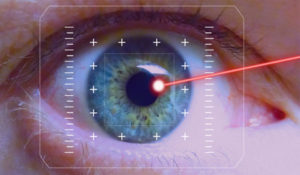LASER
 In modern days of ophthalmic treatment LASER procedures are very safe and useful. Our hospital is equipped with YAG laser for capsulotomy and peripheral iridotomy. Retinal green laser is also available for treatment of retinal disease like diabetic retinopathy.
In modern days of ophthalmic treatment LASER procedures are very safe and useful. Our hospital is equipped with YAG laser for capsulotomy and peripheral iridotomy. Retinal green laser is also available for treatment of retinal disease like diabetic retinopathy.
There are the different types of corrective surgeries, what they improve, and how they work:
LASIK (laser in-situ keratomileusis)
This surgery reshapes the underlying corneal tissue to focus light into the eye and reach the retina. This procedure is ideal for patients who are nearsighted, farsighted, or have astigmatism. What makes LASIK unique is its methodology. Eye surgeons create a flap of the outside layer of the cornea in order to access the underlying tissue. The procedure requires precision, and advancements in computer imaging technology allow LASIK specialists to create detailed corneal images and guide the treatment.
PRK (photorefractive keratectomy)
PRK is a procedure that uses a laser to reshape the cornea. Unlike LASIK, PRK only reshapes the surface of the cornea. It’s ideal for mild to moderate nearsightedness, farsightedness, or astigmatism. PRK can also work with computer imaging technology.
LASEK (laser epithelial keratomileusis)
This procedure is a slight variation of PRK. The doctor will create a flap where epithelial cells are loosened by applying an alcohol solution. Then, a laser reshapes the cornea and the flap is set and secured with a soft contact lens so that it can heal around the correction. LASEK treats nearsightedness, farsightedness, and astigmatism.
ALK (automated lamellar keratoplasty)
ALK can help people with severe nearsightedness and few levels of farsightedness, although LASIK has all but replaced ALK as a method of correction. For this procedure, an eye specialists creates a flap in the cornea to access the underlying tissue. No laser is used, and instead, the doctor makes an incision in the sub-layer of the cornea to reshape and correct vision.
RLE (refractive lens exchange).
RLE is a procedure for correcting cataracts. The doctor makes a small incision to remove the natural lens of the eye on the edge of the cornea. The lens is replaced with a silicone or plastic lens. This procedure is also known as CLE (clear lens extraction) or RLR (refractive lens replacement) and can be used to correct severe farsightedness or nearsightedness. It is also used to correct thin corneas, dry eyes, and other minor eye problems. Additional procedures may be needed to correct astigmatism.
EpiLasik
The EpiLasik procedure is very similar to PRK. The doctor separates a thin layer of the cornea and then reshapes it. The layer may either be removed or replaced. The doctor finishes the procedure by applying a soft contact lens to protect the area until it can fully heal.
PRELEX (presbyopic lens exchange)
If the eye’s lens loses its flexibility, the condition is referred to as presbyopia. Patients with presbyopia have difficulty focusing on close objects. PRELEX is a procedure where the eye doctor implants a multifocal lens to improve flexibility and restore focus.
Intacs
Intacs are also known as intracorneal ring segments (ICR). For this procedure, the doctor makes a small incision in the cornea. Two crescent-shaped plastic rings are placed at the outer edge of the cornea to flatten it. The flattened cornea allows for light rays to be altered in the way they focus on the retina. ICR has been replaced by laser-based procedures to treat mild nearsightedness.
Phakic Intraocular Lens Implants
Some patients who are too nearsighted for PRK and LASIK, need Phakic Intraocular Lens Implants. For this procedure, the doctor inserts an implant through a very small incision at the edge of the cornea that attaches to the iris behind the pupil. The eye’s natural lens is left in place.
AK (astigmatic keratonomy)
AK is a surgery that corrects an astigmatism without the use of a laser. People with astigmatism have corneas that are shaped like a football, and this surgery corrects that by making one or two incisions at the steepest part of the cornea. After the incisions are made, the cornea relaxes and takes a more rounded shape. AK can be performed alone or with other laser eye surgeries.